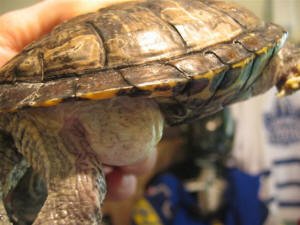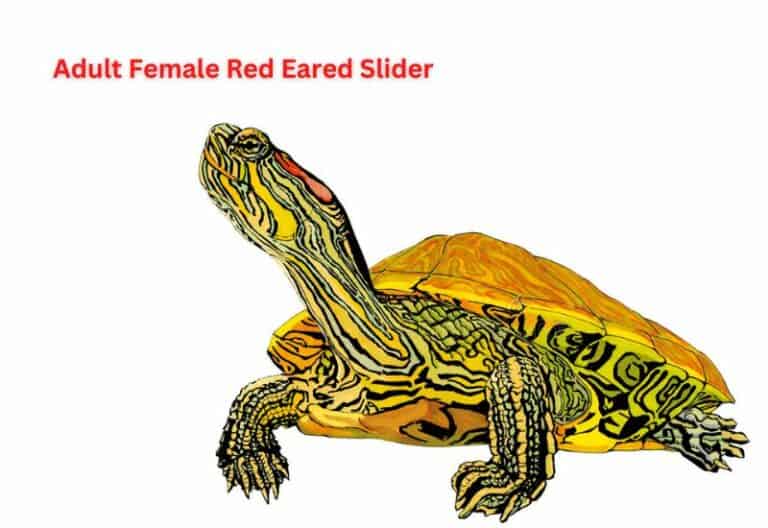Understanding Red Eared Slider Turtle Diseases: A Comprehensive Guide
Red eared slider turtle diseases can be troubling for any turtle owner. But fret not, as we’ve got you covered! In this article, we will dive deep into the world of red eared slider turtle diseases and provide you with the essential knowledge to keep your turtles healthy and happy. Whether you’re a new turtle owner or a seasoned pro, understanding these potential health issues is crucial for the wellbeing of your aquatic companions. So, let’s plunge in and explore the fascinating world of red eared slider turtle diseases together!
Red Eared Slider Turtle Diseases
Red eared slider turtles, also known as Trachemys scripta elegans, are popular pets due to their vibrant appearance and relative ease of care. However, just like any living creature, they can be susceptible to various diseases and health issues. It is crucial for turtle owners to be aware of these potential ailments to ensure the well-being and longevity of their pets. In this comprehensive guide, we will explore the most common diseases that can affect red eared slider turtles, their causes, symptoms, treatment options, and preventive measures.
1. Shell Rot
Shell rot is a common ailment among red eared slider turtles that primarily affects their hard outer shell, known as the carapace. It is typically caused by a bacterial or fungal infection and is often a result of poor water quality, inadequate diet, or trauma. Some common symptoms of shell rot include:
- Softening or pitting of the shell
- Discoloration, such as white or yellow patches
- Foul odor emanating from the shell
- Decreased activity or reluctance to swim
If you suspect shell rot in your red eared slider, it is crucial to address the issue promptly. Treatment often involves improving water quality, adjusting the turtle’s diet, and applying topical medications prescribed by a veterinarian.
2. Respiratory Infections
Respiratory infections are another common health issue that affects red eared sliders. These infections can be caused by bacteria, fungi, or viruses and are often a result of poor environment conditions, such as low water temperature or inadequate basking areas. Some signs of respiratory infections in turtles include:
- Labored breathing or wheezing
- Nasal discharge
- Lethargy or loss of appetite
- Swollen eyes
If you notice any of these symptoms, it is vital to seek veterinary assistance. Treatment may involve administering antibiotic or antifungal medications, providing a warm and humid environment, and addressing any underlying causes.
3. Parasitic Infections
Parasitic infections are prevalent in red eared slider turtles and can have a significant impact on their overall health. Common parasites that affect these turtles include worms (such as roundworms and tapeworms), flukes, and protozoa. Symptoms of parasitic infections may vary depending on the type of parasite but can include:
- Weight loss
- Diarrhea or abnormal feces
- Lethargy
- Loss of appetite
To diagnose and treat parasitic infections, a veterinarian will typically perform a fecal examination and prescribe appropriate medications. Additionally, maintaining clean tank conditions and feeding a balanced diet can help prevent these infections.
4. Vitamin Deficiencies
Vitamin deficiencies can significantly impact the health of red eared slider turtles. One common deficiency is of vitamin A, which can occur due to an imbalanced diet that lacks proper sources of this essential nutrient. Signs of vitamin A deficiency in turtles include:
- Swollen or closed eyes
- Loss of appetite
- Respiratory issues
- Abnormal growth or shell deformities
Supplementation of vitamin A, either through dietary adjustments or oral supplements prescribed by a veterinarian, can help resolve the deficiency. However, it is essential to ensure appropriate dosages and consult with a professional.
5. Shell Injuries
Red eared slider turtles have a protective shell, but they are still susceptible to shell injuries. These injuries can occur due to rough handling, falls, or attacks from other pets. Common shell injuries include cracks, fractures, or complete breaks. Some signs of shell injuries include:
- Bleeding
- Visible cracks or breaks in the shell
- Lethargy or hiding behavior
- Loss of appetite
If your red eared slider turtle sustains a shell injury, it is crucial to seek immediate veterinary care. Depending on the severity of the injury, treatment options may include cleaning the wound, stabilizing the shell, and administering appropriate medications.
6. Eye Infections
Eye infections can also affect red eared slider turtles and can be caused by bacteria, fungi, or viral agents. Poor water quality or inadequate diet can contribute to the development of these infections. Common symptoms of eye infections include:
- Swollen or red eyes
- Discharge or crust around the eyes
- Loss of appetite
- Excessive blinking or rubbing of the eyes
Treatment for eye infections typically involves applying topical medications as prescribed by a veterinarian and addressing any underlying causes, such as water quality or diet.
7. Egg Retention
Female red eared slider turtles occasionally experience egg retention, where they are unable to lay their eggs. This condition can be life-threatening and requires immediate veterinary attention. Signs of egg retention include:
- Swollen abdomen
- Restlessness or discomfort
- Decreased appetite
- Visible straining or attempting to lay eggs
A veterinarian will assess the condition and may attempt manual extraction of the eggs or administer medications to stimulate egg laying. Preventive measures include providing a suitable nesting area and maintaining optimal breeding conditions.
8. Metabolic Bone Disease
Metabolic bone disease occurs due to calcium and vitamin D3 deficiencies in red eared slider turtles. Inadequate diet, lack of UVB lighting, or impaired calcium absorption can contribute to the development of this disease. Symptoms of metabolic bone disease include:
- Softening or deformities of the shell
- Lameness or inability to use limbs
- Loss of appetite
- Tremors or muscle twitches
Treatment of metabolic bone disease may involve dietary adjustments, UVB supplementation, and calcium and vitamin D3 supplements, as advised by a veterinarian.
9. Pancreatic Infection
Pancreatic infections, although less common, can affect red eared slider turtles. These infections are typically bacterial in nature and can occur due to underlying health issues or poor husbandry practices. Symptoms of pancreatic infections include:
- Loss of appetite
- Weight loss
- Diarrhea or abnormal feces
- Lethargy
Veterinary intervention is crucial for the diagnosis and treatment of pancreatic infections. Treatment typically involves antibiotic therapy and supportive care to address any underlying conditions.
10. Toxicosis
Toxicosis in red eared slider turtles can occur due to exposure to various toxins, such as chemicals, pesticides, or contaminated water. Symptoms of toxicosis may vary depending on the specific toxin but can include:
- Behavioral abnormalities
- Loss of appetite
- Respiratory issues
- Internal organ damage
Immediate veterinary care is essential if you suspect your red eared slider has been exposed to toxins. Treatment will depend on the type and severity of the toxicity and may involve supportive care and detoxification protocols.
Remember, proper husbandry, regular veterinary check-ups, and a balanced diet are paramount in preventing and managing various diseases in red eared slider turtles. By staying informed and attentive to your turtle’s overall well-being, you can ensure a long and healthy life for your beloved pet.
How to Treat Turtle’s Aural Abscess by a Veterinarian
Frequently Asked Questions
What are common diseases that affect red-eared slider turtles?
Red-eared slider turtles can be prone to various diseases, including shell rot, respiratory infections, eye infections, and parasitic infections.
How can I prevent shell rot in my red-eared slider turtle?
To prevent shell rot, it is important to maintain clean and proper water conditions, provide proper basking areas with heat and UVB light, and regularly inspect the shell for any signs of damage or infection.
What are the symptoms of respiratory infections in red-eared slider turtles?
Common symptoms of respiratory infections in red-eared slider turtles include wheezing or labored breathing, nasal discharge, swollen eyes, and lethargy. If you notice these signs, it is important to seek veterinary care for your turtle.
How can I treat eye infections in my red-eared slider turtle?
If your red-eared slider turtle has an eye infection, it is important to seek veterinary advice for proper diagnosis and treatment. Treatment may involve the use of antibiotic eye drops or ointment, and it is essential to keep the turtle’s environment clean to prevent further infection.
Can red-eared slider turtles get parasitic infections?
Yes, red-eared slider turtles can be affected by parasitic infections. Internal parasites such as worms or protozoa can cause health issues. Regular fecal exams by a veterinarian, proper hygiene practices, and a balanced diet can help prevent and manage parasitic infections.
What should I do if I suspect my red-eared slider turtle is sick?
If you suspect your red-eared slider turtle is sick, it is important to consult a veterinarian who specializes in reptile care. They can properly diagnose the issue and provide appropriate treatment. Early detection and prompt intervention are crucial for the well-being of your turtle.
Final Thoughts
In conclusion, red eared slider turtle diseases are a concerning issue that requires attention. These diseases, such as respiratory infections, shell rot, and parasites, can lead to severe health complications for the turtles. It is crucial for turtle owners to be aware of the symptoms, provide proper care, and seek veterinary assistance when necessary. Regular cleaning of the habitat, maintaining optimal water temperature, and a balanced diet can help prevent these diseases. By taking proactive measures, we can ensure the well-being and longevity of red eared slider turtles.

